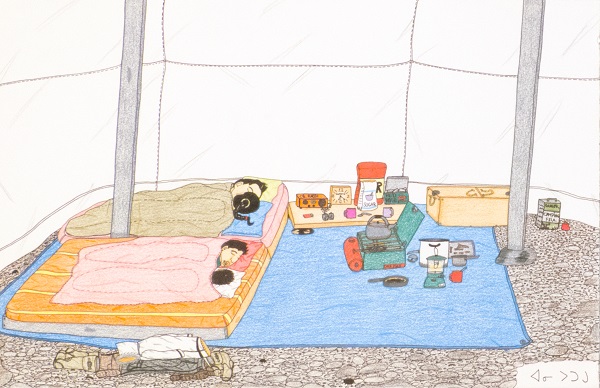Prints and drawings by three generations of Inuit women offer a fascinating glimpse into remote Canadian Arctic life at the Armory Center for the Arts. “Akunnittinni,” the show’s Inuktitut title translated as “between us,” fittingly summarizes its convergence of a Baffin Island mother, daughter and granddaughter who directed art towards societal, familial and autobiographical documentation. Each espoused a unique personal voice. Stonecut prints by Pitseolak Ashoona (1904-1983) spotlight spirituality, animals and recollections of the traditional nomadic lifestyle of her childhood. With forms reduced to stylized, dreamlike essences, her centralized compositions incorporate small repeated motifs surrounded by ample expanses of bare white paper that evoke vast frozen landscapes dwarfing all life. Pitseolak’s wistful totemic scenes appear quaint compared with unsettling drawings by her daughter, Napachie Pootoogook (1938-2002), who highlighted social problems and harsh realities of subsistence. With wry humor and a sensitive eye for nuanced facial expression, several of Napachie’s drawings graphically portray violence and women’s oppression by male Inuit and non-Inuit. Embodying the most colorful palette and contemporary manner, Napachie’s daughter, Annie Pootoogook (1969-2016) delineated the modernization that had infiltrated their rural village of Kinngait. Clad in baseball caps and jeans, her protagonists are surrounded by tokens of modern urban society: shiny gadgets, blaring logos and prepackaged foods fill their humble homes. Works by this matrilineal trio together evince how much Inuit life had changed over the last century; but from Pitseolak’s Dream of Motherhood (1969) to Napachie’s Eating his Mother’s Remains (1999-2000) to Annie’s Family Sleeping in A Tent (2003-2004, pictured above), ancestry has remained their common denominator.
Armory Center for the Arts
145 North Raymond Avenue
Pasadena, CA 91103
Show runs through Dec. 16



















0 Comments